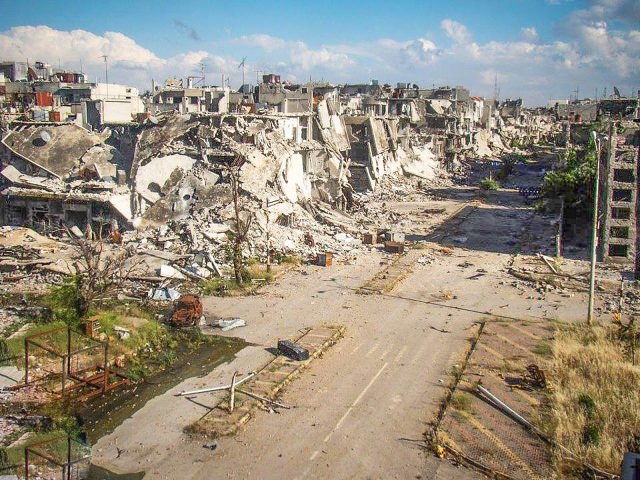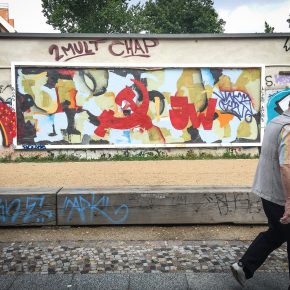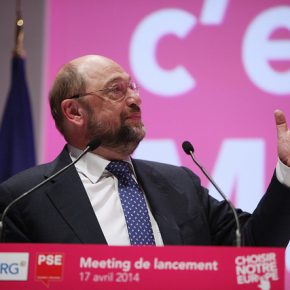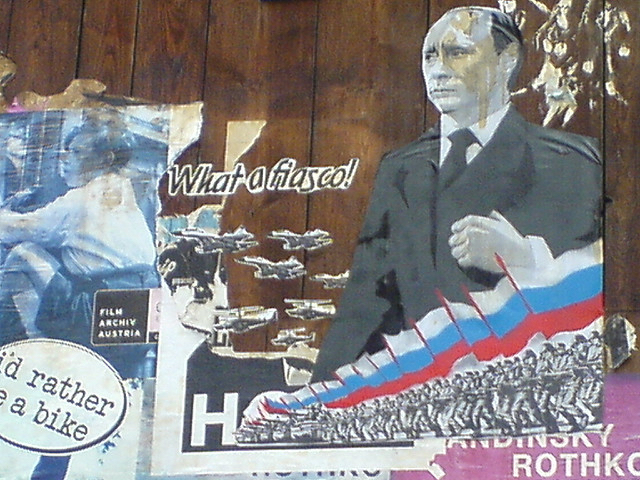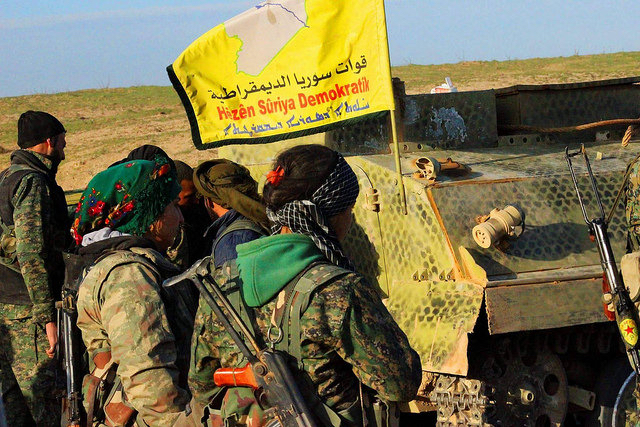Author Joseph Daher examines the Syrian government’s reconstruction strategy and warns that Assad will use rebuilding to reward foreign allies and consolidate power around a small core of Syrian elite.
BEIRUT – The Syrian government’s plans for rebuilding the country’s wrecked cities and governorates are starting to take shape, but there are warning signs the process may not necessarily be geared towards recovery and renewal, according to Swiss-Syrian academic and author Joseph Daher.
Daher argues that two ulterior motives underlie the Syrian government’s approach to reconstruction: Consolidating political and economic power within a narrow circle of Syrian elites connected to the ruling Assad family and quelling dissent in former opposition areas.
Syria Deeply spoke with Daher about the current approach to reconstruction in Syria, the informal business networks shaping government plans, and what this all could mean for the country’s future.
Syria Deeply: What is the Syrian government’s current model for reconstruction? Have they begun to implement it?
Joseph Daher: The Syrian regime lacks funds, reserves and is in massive debt, so it needed to develop a privatization model that could fund the reconstruction process. Currently, the main reconstruction model comes in the form of Public Private Partnership (PPP), which includes a strong privatization component and, consequently, increased economic liberalization.
In May 2015, President Bashar al-Assad issued a presidential decree (Decree 19) allowing administrative units, including governorates and municipalities, to establish their own private investment companies. In January 2016, the government passed the PPP law, six years after it was originally drafted, authorizing the private sector to manage and develop state assets in all sectors of the economy, except for oil. This privatization model is part of the Syrian government’s new economic strategy, named the National Partnership, launched in February 2016, to replace the social market economic model developed prior to the uprising.
Already, there are several examples of the PPP model being implemented in the reconstruction process. The Damascus Cham Holding Joint Stock Company was established by the Damascus governorate in December 2016 with a capital of 60 billion Syrian pounds (about $279 million). The company, which is headed by the Damascus governor himself, is in charge of funding a massive urban redevelopment project in the Basateen al-Razi district of Damascus. The 2.6 million square yard- (2.15 million square meter-) development is expected to provide 12,000 housing units for an estimated 60,000 residents. It is also expected include schools, restaurants, places of worship, a multistory car park and a shopping mall.
Similarly, in March of 2017, the municipality of Homs established its own holding company to handle real estate projects for the reconstruction of the Baba Amr neighborhood. The reconstruction plan is expected to provide 465 plots, mainly for residential housing, in addition to public spaces and services such as schools and hospitals.
Private-sector investments, however, are not sufficient for the reconstruction of the entire country. PPP schemes largely rely on financing from banks, but banks in Syria do not have the capital to fund reconstruction. The total assets of 14 private sector commercial banks operating in Syria were estimated at 1.7 trillion Syrian pounds ($3.5billion) at the end of 2016. Meanwhile, in April 2017, U.N. agencies estimated war damage across Syria at $350 billion – a figure that clearly exceeds the current financial capacity of banks. This is why for larger reconstruction projects, Foreign Direct Investments (FDI) will have to be included, further strengthening the process of privatization.
Syria Deeply: The Syrian state cannot finance its own reconstruction, so it will have to rely on foreign funding. What states could be included in these agreements, and what will their involvement mean for postwar Syria?
Daher: The states that will benefit are definitely the countries allied to the Assad regime, particularly Iran, Russia and China. India and Brazil might also benefit from the reconstruction drive. Assad and Syrian officials have repeatedly declared that companies from allied countries will be rewarded, while European and American companies will first need to have their governments apologize for supporting the opposition before benefiting. Damascus has also adopted a similar position towards Saudi Arabia, Qatar and Turkey for the current period.
Deals worth at least €850 million ($1.01 billion) with Russian companies were announced in October 2015 following a visit of a Russian delegation to Damascus. In November 2016, Syrian foreign minister Walid Muallem reportedly offered Russian firms priority in rebuilding Syria following a visit of Russian deputies.
In early August, the Chinese government hosted the “First Trade Fair on Syrian Reconstruction Projects,” during which a Chinese-Arab business group announced a $2 billion commitment from the government for the construction of industrial parks in Syria.
Iran, for its part, is also expected to play a major role in reconstructing Syria, and there are already some early signs of Tehran’s involvement. On Tuesday, Iran said it would rehabilitate and reconstruct electricity infrastructure in Damascus and Deir Ezzor, and an Iranian company was awarded a contract to supply electricity to Aleppo. Iran is also slated to build a power plant in Latakia province. What’s more, the Iranian Reconstruction Authority in March of 2017 announced plans to rehabilitate 55 schools in Aleppo province. Aleppo governor Hossein Diyab said at the time that Iran was going to “play an important role in reconstruction efforts in Syria, especially Aleppo.” Tehran has already started preparations for small-scale reconstruction efforts.
The economic investment of these foreign players will most probably translate into even more political influence in Syria, especially for Iran and Russia.
Syria Deeply: Prior to the outbreak of the Syrian conflict, the country’s economy and form of governance was referred to by scholars and academics as ‘patrimonial.’ What is patrimonialism and how might it influence the reconstruction process?
Daher: Patrimonialism is a form of governance in which the centers of power (political, military and economically) within a regime are concentrated in one family and its clique, just as in Syria with Assad’s family.
In patrimonial regimes, you have the development of a form of crony capitalism, dominated by a state bourgeoisie. In other words, the circles close to the ruling family will often exploit their dominance to amass considerable fortunes. The main sectors of the economy in Syria prior to the uprising were dominated by businessmen with direct connections to the regime.
The “business” of reconstruction is in this perspective no different from other sectors of the economy: The main contracts will benefit businessmen linked to the regime and will reward foreign allies for their assistance with a share of the market.
There are already some early examples of this happening. For example, Syria’s metal industry is slated to benefit largely from the reconstruction drive, and the regime is already positioning its capitalist associates in order for them to reap the benefits of this new opportunity. In mid-December of 2015, the Syrian Metals and Steel Council was established with the aim of lobbying for a sector that will benefit from the reconstruction drive. The council is made up of a 17-member board, all of whom were designated by the Syrian prime minister.
What’s more, the head of the council is a known crony capitalist, Mohammad Hamcho, who was sanctioned by the U.S. treasury for his ties with the Assad regime and particularly to the president’s brother, Maher al-Assad. Other members of the board also included a collection of well-connected Syrian investors, three of whom were also under U.S. treasury sanctions: Ayman Jaber and the two Hamcho brothers, Imad and Samir. These businessmen that enjoy close ties to the regime are slated to make considerable profit as demand for metal and steel rises with the start of mass reconstruction.
Syria Deeply: The primary aim of post-conflict reconstruction in any context is economic and infrastructural renewal/recovery. What additional objectives are at play in the Syrian context?
Daher: Firstly, reconstruction, as a project, will help the regime and crony capitalists consolidate their political and economic power, while also rewarding foreign allies for their support by granting them a sizable share of the market. As such, reconstruction will consolidate and even reinforce the patrimonial nature of the state.
Secondly, the reconstruction process will also help the regime crackdown on dissent in certain areas. In September 2012, Assad signed a legislative decree known as Decree 66, which allows the government to “redevelop areas of unauthorized housing and informal settlements [slums].” This policy will allow for the transfer of assets to private companies and regime cronies free of taxes. It will also provide the legal and financial framework for reconstruction by allowing for the destruction and expropriation of large parts of the country and the dispossession of a number of people.
The government can leverage this decree to use reconstruction as a punishing measure against [the part of the] population known for their opposition to the regime. This is the case with the two large informal districts of Damascus (the first in the Mezzeh district and the other in a large area extending from Qadam to Daraya) and Baba Amro neighborhood in Homs, which are being rebuilt while the majority of its population is outside of Syria or in other areas of the country. In both cases, the most probable scenario is the replacement of these hostile Sunni impoverished constituencies by middle and wealthy higher classes, from various religious backgrounds, including Sunnis, less willing to oppose the government.
This article originally appeared on Syria Deeply, and you can find the original here. Photograph courtesy of H.usa. Published under a Creative Commons license.
